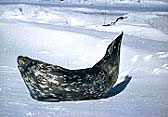Weddell Seal
Weddell Seal Sounds (Leptonychotes weddelli)
Description

Weddell seal with pup. Photo courtesy of Jeanette Thomas, Laboratory of Sensory Biology, Western Illinois University.
Weddell seals are found only in the Antarctic region. These seals can dive for up to 73 minutes and reach a depth of 600 m (almost 2,000 ft), though they mostly dive to 300-400 m (980-1310 ft).They are one of the largest seals. Adults are approximately 3 m (9.8 ft) long and can weigh as much as 400-600 kg (880-1320 lb). They have very large bodies and tiny heads. It has been said that the Weddell seal’s appearance is as if someone made a mistake while putting the animal together because its head is so small compared to its body. Their fur is dark on the top of the body and lighter underneath, with many silver or white streaks or splashes. Weddell seals are versatile feeders, eating fish, crustaceans, and cephalopods, though they have also been observed to eat chinstrap penguins. They are very creative at extracting fishes from ice crevices. If a fish hides in a crevice, the seal blows bubbles into the water to chase the fish into open water.
Weddell seals make many different types of underwater vocalizations that are used in social interactions. Specific calls are used in territorial displays while others are used in aggression. Weddell seals produce trills, whistles, low frequency buzzes, and chirps. The frequency range of vocalizations is 80 Hz – 24 kHz.

Weddell seal. Photo courtesy of Jeanette Thomas, Laboratory of Sensory Biology, Western Illinois University.
Additional Resources
- Scripps Institution of Oceanography, Voices in the Sea
- Australian Antarctic Division, Weddell Seal